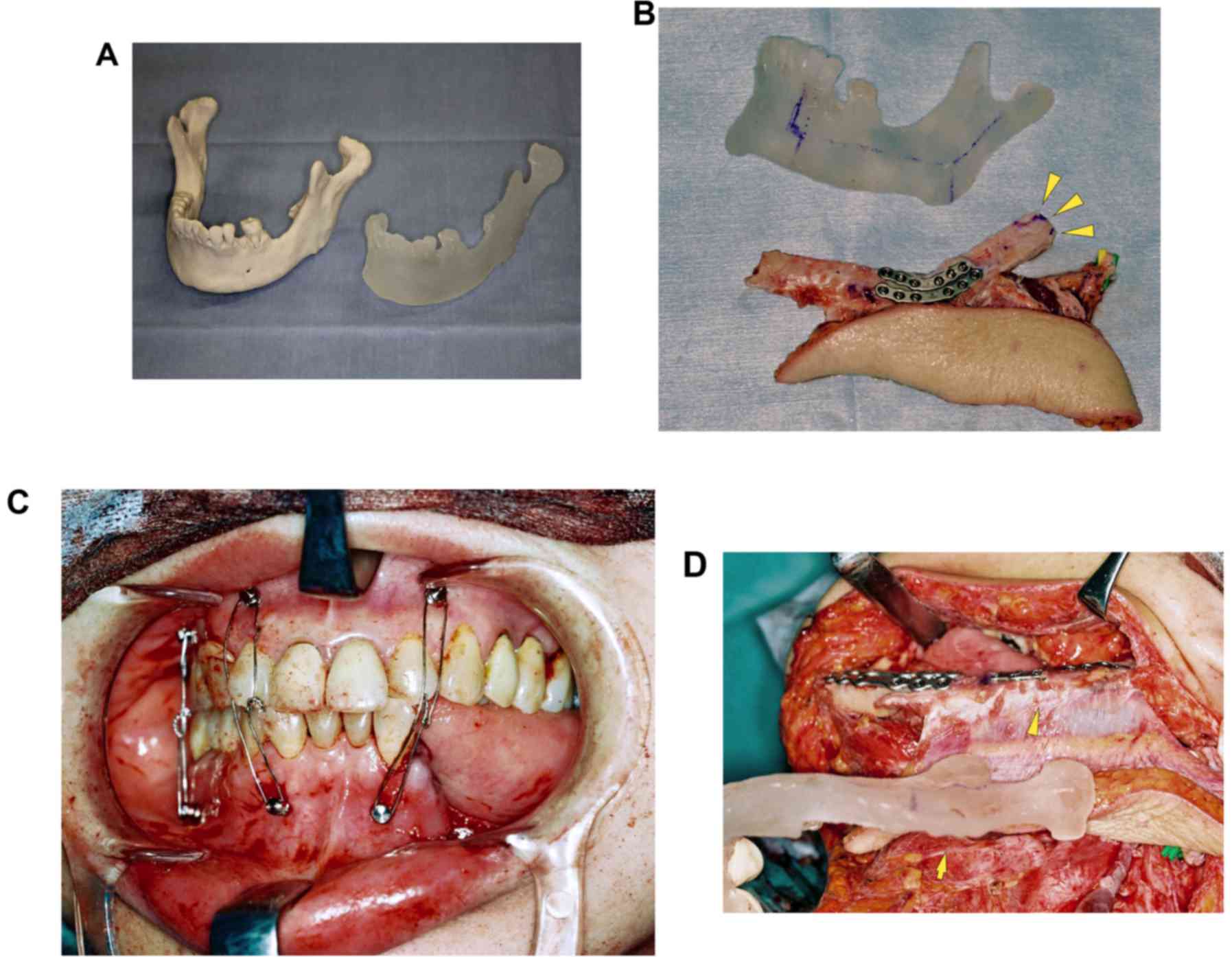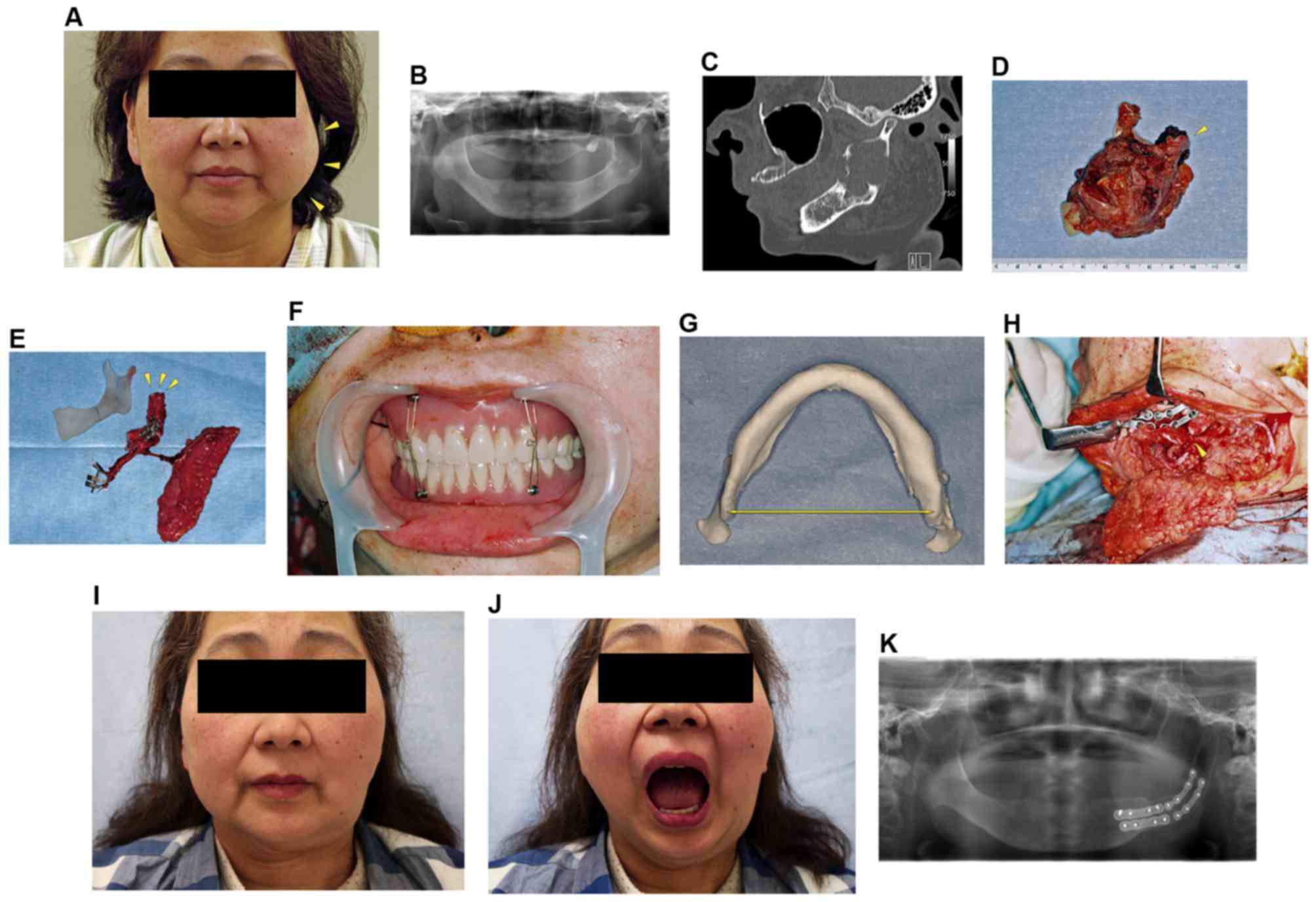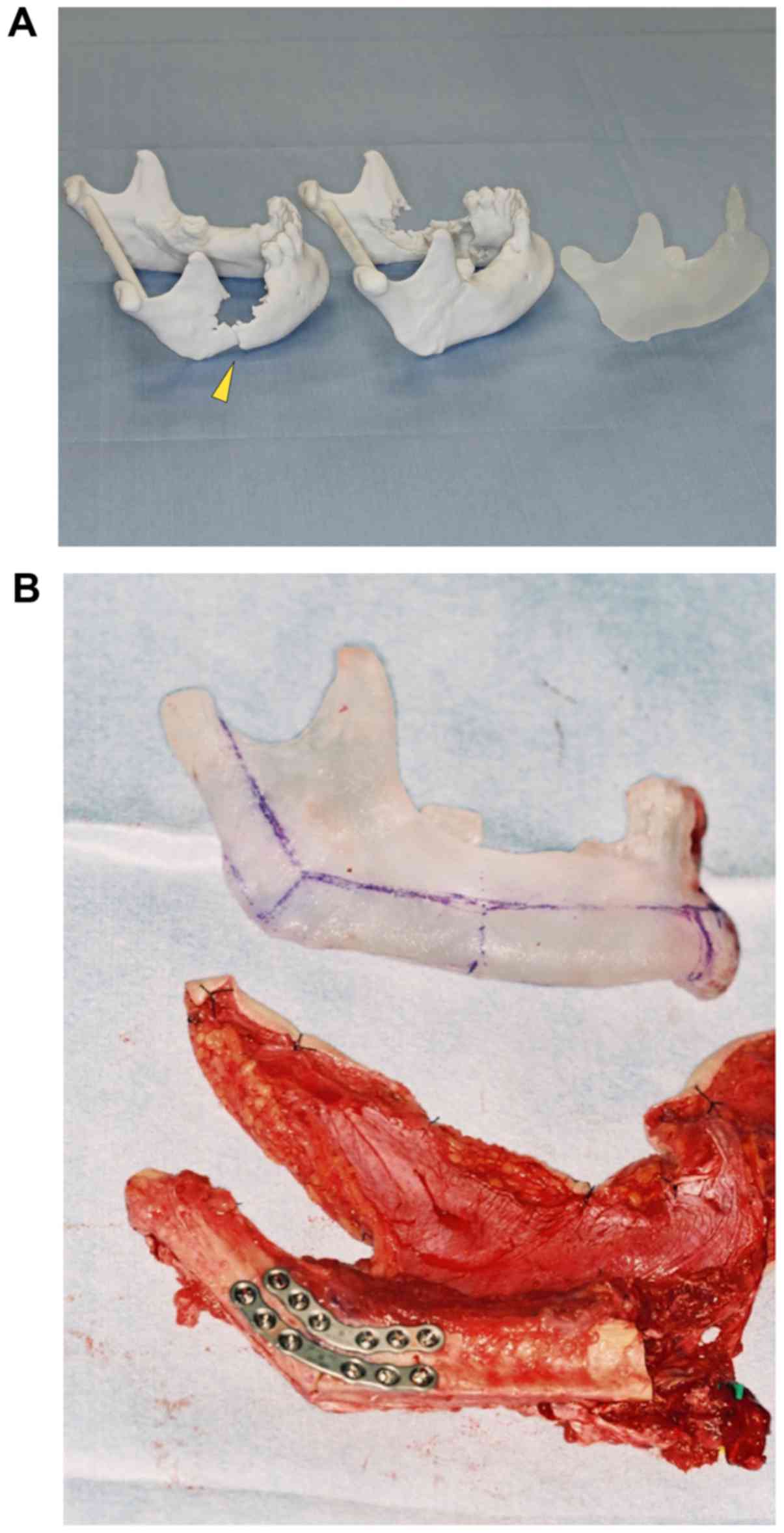|
1
|
Potter JK and Dierks EJ: Vascularized
options for reconstruction of the mandibular condyle. Semin Plast
Surg. 22:156–160. 2008. View Article : Google Scholar : PubMed/NCBI
|
|
2
|
Iñigo F, Rojo P, Ysunza A and Jimenez Y:
Three different techniques for mandibular reconstruction after
hemimandibulectomy. J Craniofac Surg. 8:58–64. 1997. View Article : Google Scholar : PubMed/NCBI
|
|
3
|
Wax MK, Winslow CP, Hansen J, MacKenzie D,
Cohen J, Andersen P and Albert T: A retrospective analysis of
temporomandibular joint reconstruction with free fibula
microvascular flap. Laryngoscope. 110:977–981. 2000. View Article : Google Scholar : PubMed/NCBI
|
|
4
|
Guyot L, Richard O, Layoun W, Cheynet F,
Bellot-Samson V, Chossegros C, Blanc JL and Gola R: Long-term
radiological findings following reconstruction of the condyle with
fibular free flaps. J Craniomaxillofac Surg. 32:98–102. 2004.
View Article : Google Scholar : PubMed/NCBI
|
|
5
|
Engroff SL: Fibula flap reconstruction of
the condyle in disarticulation resections of the mandible: A case
report and review of the technique. Oral Surg Oral Med Oral Pathol
Oral Radiol Endod. 100:661–665. 2005. View Article : Google Scholar : PubMed/NCBI
|
|
6
|
Khariwala SS, Chan J, Blackwell KE and
Alam DS: Temporomandibular joint reconstruction using a
vascularized bone graft with Alloderm. J Reconstr Microsurg.
23:25–30. 2007. View Article : Google Scholar : PubMed/NCBI
|
|
7
|
González-García R, Naval-Gías L,
Rodríguez-Campo FJ, Martínez-Chacón JL and Gil-Díez Usandizaga JL:
Vascularized fibular flap for reconstruction of the condyle after
mandibular ablation. J Oral Maxillofac Surg. 66:1133–1137. 2008.
View Article : Google Scholar : PubMed/NCBI
|
|
8
|
Thor A, Rojas RA and Hirsch JM: Functional
reconstruction of the temporomandibular joint with a free fibular
microvascular flap. Scand J Plast Reconstr Surg Hand Surg.
42:233–240. 2008. View Article : Google Scholar : PubMed/NCBI
|
|
9
|
Moore EJ and Hamilton SS: Mandibular
condyle reconstruction with fibula free-tissue transfer. Ear Nose
Throat J. 91:E18–E24. 2012.PubMed/NCBI
|
|
10
|
Wang WH, Zhu J, Deng JY, Xia B and Xu B:
Three-dimensional virtual technology in reconstruction of
mandibular defect including condyle using double-barrel
vascularized fibula flap. J Craniomaxillofac Surg. 41:417–422.
2013. View Article : Google Scholar : PubMed/NCBI
|
|
11
|
Bredell M, Grätz K, Obwegeser J and Gujer
AK: Management of the temporomandibular joint after ablative
surgery. Craniomaxillofac Trauma Reconstr. 7:271–279. 2014.
View Article : Google Scholar : PubMed/NCBI
|
|
12
|
Chao JW, Rohde CH, Chang MM, Kutler DI,
Friedman J and Spector JA: Oral rehabilitation outcomes after free
fibula reconstruction of the mandible without condylar restoration.
J Craniofac Surg. 25:415–417. 2014. View Article : Google Scholar : PubMed/NCBI
|
|
13
|
Hoang MP, Nguyen TT, Nguyen LK and Jeng
SF: Ossifying fibroma of the mandible: A case report using
vascularized free fibula flap reconstruction. Plast Reconstr Surg
Glob Open. 3:e4702015. View Article : Google Scholar : PubMed/NCBI
|
|
14
|
Smith M, Williams F and Ward BB: Hard
tissue reconstructionManagement of Complications in Oral and
Maxillofacial Surgery. Miloro M and Kolokythas A: 1st.
Wiley-Blackwell; Oxford: pp. 283–316. 2012
|
|
15
|
Antony AK, Chen WF, Kolokythas A, Weimer
KA and Cohen MN: Use of virtual surgery and
stereolithography-guided osteotomy for mandibular reconstruction
with the free fibula. Plast Reconstr Surg. 128:1080–1084. 2011.
View Article : Google Scholar : PubMed/NCBI
|
|
16
|
List MA, Ritter-Sterr C and Lansky SB: A
performance status scale for head and neck cancer patients. Cancer.
66:564–569. 1990. View Article : Google Scholar : PubMed/NCBI
|
|
17
|
Urken ML, Weinberg H, Vickery C,
Buchbinder D, Lawson W and Biller HF: Oromandibular reconstruction
using microvascular composite free flaps. Report of 71 cases and a
new classification scheme for bony, soft-tissue, and neurologic
defects. Arch Otolaryngol Head Neck Surg. 117:733–744. 1991.
View Article : Google Scholar : PubMed/NCBI
|
|
18
|
Curtis DA, Plesh O, Miller AJ, Curtis TA,
Sharma A, Schweitzer R, Hilsinger RL, Schour L and Singer M: A
comparison of masticatory function in patients with or without
reconstruction of the mandible. Head Neck. 19:287–296. 1997.
View Article : Google Scholar : PubMed/NCBI
|
|
19
|
Vega LG, González-García R and Louis PJ:
Reconstruction of acquired temporomandibular joint defects. Oral
Maxillofacial Surg Clin North Am. 25:251–269. 2013. View Article : Google Scholar
|
|
20
|
Petruzzelli GJ, Cunningham K and
Vandevender D: Impact of mandibular condyle preservation on
patterns of failure in head and neck cancer. Otolaryngol Head Neck
Surg. 137:717–721. 2007. View Article : Google Scholar : PubMed/NCBI
|
|
21
|
Marx RE, Cillo JE Jr, Broumand V and Ulloa
JJ: Outcome analysis of mandibular condylar replacements in tumor
and trauma reconstruction: A prospective analysis of 131 cases with
long-term follow-up. J Oral Maxillofac Surg. 66:2515–2523. 2008.
View Article : Google Scholar : PubMed/NCBI
|
|
22
|
Carlson ER: Disarticulation resections of
the mandible: A prospective review of 16 cases. J Oral Maxillofac
Surg. 60:176–181. 2002. View Article : Google Scholar : PubMed/NCBI
|
|
23
|
Rosenberg AJ, Van Cann EM, van der Bilt A,
Koole R and van Es RJ: A prospective study on prognostic factors
for free-flap reconstructions of head and neck defects. Int J Oral
Maxillofac Surg. 38:666–670. 2009. View Article : Google Scholar : PubMed/NCBI
|
|
24
|
Nahabedian MY, Tufaro A and Manson PN:
Improved mandible function after hemimandibulectomy, condylar head
preservation, and vascularized fibular reconstruction. Ann Plast
Surg. 46:506–510. 2001. View Article : Google Scholar : PubMed/NCBI
|
|
25
|
Xu LQ, Zhang CP, Poh EH, Yin XL and Shen
SK: A novel fibula osteotomy guide for mandibular reconstruction.
Plast Reconstr Surg. 129:861e–863e. 2012. View Article : Google Scholar : PubMed/NCBI
|
|
26
|
Hanasono MM and Skoracki RJ:
Computer-assisted design and rapid prototype modeling in
microvascular mandible reconstruction. Laryngoscope. 123:597–604.
2013. View Article : Google Scholar : PubMed/NCBI
|
|
27
|
Lim SH, Kim MK and Kang SH: Precision of
fibula positioning guide in mandibular reconstruction with a fibula
graft. Head Face Med. 12:72016. View Article : Google Scholar : PubMed/NCBI
|
|
28
|
Mast G: Techniques of mandibulomaxillary
fixation (MMF)Principles of Internal Fixation of the
Craniomaxillofacial Skeleton. Ehrenfeld M, Manson PN and Prein J:
1st. George Thieme Verlag; New York, NY: pp. 115–123. 2012
|
|
29
|
Markowitz BL, Roumanas E and Calcaterra T:
Surgical stents for composite mandible reconstruction. Plast
Reconstr Surg. 96:194–200. 1995. View Article : Google Scholar : PubMed/NCBI
|
|
30
|
Yoshimura H, Ohba S, Yasuta M, Nakai K,
Fujieda S and Sano K: Infrazygomatico-coronoid fixation in a
segmental mandibular reconstruction with a free vascularized flap:
A simple and correct repositioning method without interfering with
reconstructive and microsurgical procedures. Head Neck.
38:1679–1687. 2016. View Article : Google Scholar : PubMed/NCBI
|
|
31
|
McDonald F: The condylar disk as a
controlling factor in the form of the condylar head. J Craniomandib
Disord. 3:83–86. 1989.PubMed/NCBI
|
|
32
|
Hamada Y, Kondoh T, Takada N and Seto K:
MRI and arthroscopic findings in the temporomandibular joint after
mandibulectomy including the unilateral condyle. Report of two
cases. Int J Oral Maxillofac Surg. 29:341–343. 2000. View Article : Google Scholar : PubMed/NCBI
|
|
33
|
Miyamoto H, Kurita K, Ishimaru J and Goss
AN: A sheep model for temporomandibular joint ankylosis. J Oral
Maxillofac Surg. 57:812–817. 1999. View Article : Google Scholar : PubMed/NCBI
|
|
34
|
Porto G, Vasconcelos B and Silva V Jr:
Development of temporomandibular joint ankylosis in rats: A
preliminary experimental study. Int J Oral Maxillofac Surg.
37:282–286. 2008. View Article : Google Scholar : PubMed/NCBI
|
|
35
|
Dai J, Ouyang N, Zhu X, Huang L and Shen
G: Injured condylar cartilage leads to traumatic temporomandibular
joint ankylosis. J Craniomaxillofac Surg. 44:294–300. 2016.
View Article : Google Scholar : PubMed/NCBI
|
|
36
|
Xiang GL, Long X, Deng MH, Han QC, Meng QG
and Li B: A retrospective study of temporomandibular joint
ankylosis secondary to surgical treatment of mandibular condylar
fractures. Br J Oral Maxillofac Surg. 52:270–274. 2014. View Article : Google Scholar : PubMed/NCBI
|
|
37
|
Beumer J III, Marunick MT, Silverman S Jr,
Garrett N, Rieger J, Abemayor E, Penn R, Nabili V, Rezaee R, Curtis
DA, et al: Rehabilitation of tongue and mandibular
defectsMaxillofacial Rehabilitation: Prosthodontic and Surgical
Management of Cancer-Related, Acquired and Congenital Defects of
the Head and Neck. Beumer J III, Marunick MT and Salvatore JE: 3rd.
Quintessence Publishing; Hanover Park: pp. 61–154. 2011
|
|
38
|
Brand RW and Isselhard DE:
Temporomandibular jointAnatomy of Orofacial Structures. 7th. Mosby,
St. Louis: pp. 348–352. 2003
|
|
39
|
Crawford SD: Condylar axis position, as
determined by the occlusion and measured by the CPI instrument, and
signs and symptoms of temporomandibular dysfunction. Angle Orthod.
69:103–116. 1999.PubMed/NCBI
|
|
40
|
Linsen S, Schmidt-Beer U, Fimmers R,
Grüner M and Koeck B: Craniomandibular pain, bite force, and oral
health-related quality of life in patients with jaw resection. J
Pain Symptom Manage. 37:94–106. 2009. View Article : Google Scholar : PubMed/NCBI
|
|
41
|
Marunick MT and Mathog RH: Mastication in
patients treated for head and neck cancer: A pilot study. J
Prosthet Dent. 63:566–573. 1990. View Article : Google Scholar : PubMed/NCBI
|
|
42
|
Boretti G, Bickel M and Geering AH: A
review of masticatory ability and efficiency. J Prosthet Dent.
74:400–403. 1995. View Article : Google Scholar : PubMed/NCBI
|
|
43
|
Tan ZZ, Liu B, Wei JX, Zou H and Zhao YF:
Effects of mandibular odontogenic keratocyst surgery and removable
partial prostheses on masticatory performance. J Prosthet Dent.
97:107–111. 2007. View Article : Google Scholar : PubMed/NCBI
|

















